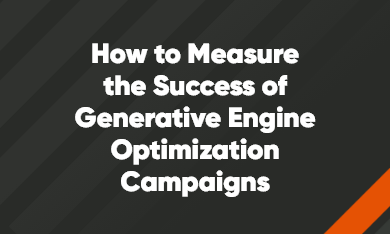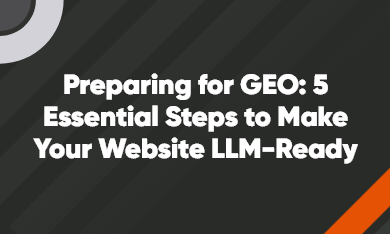
Preparing Your E-Commerce Site for LLM Checkout: SEO, AEO, and GEO Readiness
When a customer can stay within a Large Language Model (LLM) such as ChatGPT or Gemini and purchase a product without ever going to your website, will your products even be considered?
Spoiler alert: if your data and structure aren’t ready, LLMs will probably skip right past you.
Every purchase decision is made by machines that evaluate, compare, and select products on behalf of human buyers. LLMs aren’t swayed by beautiful design or clever copy. Instead, they’re looking for structured, complete, and trustworthy data that tells them exactly what a product is, who makes it, how it performs, and whether it’s in stock and ready to ship.
As an SEO agency, we're here to help you prepare for this new way of shopping. Using generative engine optimization, you can make sure your site and products are showing up and shoppable in LLMs. Let's break down LLM shopping and the steps you need to take now to optimize your e-commerce website.
Welcome to the era of “agentic commerce”
Agentic commerce is a fancy phrase for LLM-driven checkout experiences. Rather than purchasing directly from your website, users will discover and buy products within LLMs like ChatGPT or Gemini.
This is an exciting development for e-commerce businesses because it means your products could reach more potential buyers than your marketing budget previously allowed. It’s also a little nerve-wracking because the LLM checkout experience won’t take place on your website.
According to Forrester Research, this shift toward “agentic commerce” represents the next evolution of online shopping. AI assistants and LLMs can now read product data, compare options, and even complete purchases—all without human clicks (Zero-Click Search Comes for Checkout, Forrester, 2025) and (Rise of Generative Agent Commerce, Forrester, 2025).
What does all of this mean for your e-commerce business? If your product pages aren’t structured properly and full of important details, such as in-stock/out of stock updates, shipping speed, and other product specifications, LLMs may never even consider your offerings. That’s a lost sale before a human buyer ever visits your website, knows your brand, or gets on your radar!
What do we know right now about LLM checkout capabilities?
The concept of LLM-driven, AI-powered checkouts inside platforms such as ChatGPT is no longer science fiction. It’s being rolled out today in limited release (via ChatGPT) and driving real purchases for businesses using Shopify or Etsy, for single-product checkouts.
A fully automated, frictionless AI checkout everywhere is not quite our reality, but it’s not far away. Most systems today use LLMs to enhance or assist rather than replace the checkout infrastructure. The momentum is very strong: multiple payment players and AI platforms are investing, and merchant adoption is just beginning.
What does this mean for e-commerce businesses?
What’s the timeframe and level of urgency for prepping for agentic commerce? Can this wait a year? Should you hold off and see where things go?
We recommend investing in upgrades to your product catalog to make it thoroughly machine-readable and understandable as soon as possible.
Depending on the size of your product catalog, which payment processor you use (Stripe, Authorize.net, etc.), and which e-commerce platform you are on, your products may be eligible for checkout inside LLMs now, within a few months, or in the coming year.
But more pressing, with the right optimizations, LLMs can recommend your products for purchase right now. And if your website isn't optimized to get recommended, you'll miss out on sales.
To get product information ready for LLMs to understand, you need to:
- Complete the information for every visible SKU on your website
- Include additional details for every product variation
- Add page-level product schema for each and every product you sell
How will LLM checkout readiness fit into optimizing for LLMs overall?
LLM checkout changes the rules of digital visibility by adding a new layer of complexity to the traditional SEO landscape, specifically for e-commerce businesses.
Let’s break this down a little further.
For e-commerce businesses, SEO drives rankings in conventional search through keywords and backlinks. AEO, or answer engine optimization, ensures your products are mentioned in AI-generated answers pulled from product snippets, schema details, and FAQs. GEO, or generative engine optimization, pursues brand or web page citations in LLM responses. LLM checkout readiness draws on all three.
LLM checkout builds on these foundations by enabling AI-driven product selection and purchase, relying on complete, accurate, and machine-readable product data to earn visibility and trust in automated buying environments. If LLMs can’t understand your product, they won’t include it in answers for potential buyers. No clicks, no chance, no sale.
Four how-to ideas to get your e-commerce site LLM-checkout ready
Getting ready for LLM checkout isn’t just about optimizing one part of your site. There’s urgency around aligning your entire e-commerce ecosystem with how LLMs evaluate, understand, and transact—especially when customers won’t be using your site, experience, and checkout process to make a purchase. Large language models make decisions based on data quality, structure, and trust signals, not design aesthetics or ad spend.
To earn visibility (and ultimately sales) in agentic commerce environments, your product information, schema, content, and credibility must all work together.
Let’s break down the four essential areas that every brand should focus on to ensure products are AI-readable, robust, trustworthy, and ready for LLM checkouts.
1. Offer complete product information
Every successful AI-driven shopping experience begins with complete, accurate, and detailed product information. If your product data is incomplete, inconsistent, or outdated, your offerings may never be considered, no matter how high-quality they are.
- Fill out every SKU as completely as possible: title, description, price, currency, availability, and variants.
- Add descriptive context: materials, dimensions, color options, intended use, and compatibility. Add unboxing videos or product walkthroughs if you can.
- Keep everything updated for real-time: LLMs rely on real-time information that’s available on your site in terms of stock levels, available colors and sizes, shipping time, reviews on quality, reliability, and ease of use, details about the product (materials, contents, setup instructions) to make confident recommendations to someone who is looking to buy.
Complete product information is the foundation of LLM checkout readiness, but it works best when paired with structured data. By combining robust product details with clear schema and scannable content, you create pages that are not only informative to humans but also fully machine-readable, increasing the chances that your products are surfaced by LLMs in their answers back to users.
Providing complete product information transforms your catalog into a trustworthy, AI-ready resource. LLMs can confidently recommend your products for purchase, turning your data into visibility, engagement, recommended purchases, and ultimately, sales. When it comes to LLM checkout readiness, product info completeness isn’t optional. It’s the first step to being chosen.
2. Get your product schema and structured data ready
Structured data acts as your product’s instruction manual for LLM recommendations on what someone should buy. While humans can interpret images and text in context, LLMs rely on clearly defined information to understand exactly what your product is, how it works, how it might match with a user’s intended use, and why it matters.
Even the most compelling product page can remain invisible to AI-driven shopping systems without the right schema in place. Schema makes it easy for LLMs to accurately parse your offerings, surface them in recommendations, and consider them for purchase.
Let’s think about structured data as your AI-facing cheat sheet for each product, which allows LLMs to instantly recognize and interpret your products.
- Use product schema on each and every individual product page.
- Enhance your product schema for each product with as much optional info as possible with AggregateRating, ReviewCount, FAQ, HowTo, and VideoObject.
- Validate your schema using Google’s Rich Results Test or a structured data validator.
3. Create content for each product and product line that is unique and AI-friendly
Creating AI-friendly product content goes beyond catchy copy or marketing slogans. Your product pages must communicate clearly, concisely, and with factual depth so LLMs can understand, evaluate, and accurately recommend your products. Every description, specification, and user insight contributes to product discoverability by both humans and AI.
More information also helps LLMs understand the intent and context behind why someone might purchase your product, how it can be used, and what to expect in terms of adding it into their home, daily routine, or lifestyle.
Which types of product content are LLMs drawn to?
LLMs prefer product information that’s clear, factual, and scannable. They’re not impressed by marketing fluff. This is where user-generated content, such as tagged images, unboxing videos, or how-tos, can add dimension to your product pages.
- Keep descriptions compact but detailed enough for understanding.
- Add features that bring in relevant customer reviews and testimonials.
- Use bullet points, comparison tables, and question-based subheads.
- Include FAQs that answer common buyer questions like “Does this product ship internationally?” or “Does this product come with a power cord?”
Developing content that is unique, structured, and scannable improves human readability and signals to LLMs that your products are complete, trustworthy, up-to-date, and ready for recommendation. Incorporating detailed descriptions, FAQs, customer reviews, and comparison tools ensures your product pages stand out in both traditional search results and AI-driven purchase environments, maximizing visibility and sales potential.
4. Build trust and credibility throughout your product pages
Having complete product information is necessary—but it’s not enough to get LLMs to recommend your products or brand. LLMs also assess the trustworthiness of your brand and offerings across the web.
LLMs don’t just rely on your data; they evaluate your brand’s information (known as ‘trust signals’) across the web.
- Reviews and ratings: verified purchase data is gold.
- Third-party mentions: press citations, influencer endorsements, and reputable backlinks.
- Brand and author credentials: clear evidence of expertise, legitimacy, authenticity, and recency.
Brand trust isn’t built in isolation. It comes from a combination of verified reviews, third-party mentions, and clear brand credentials. These elements reinforce your product’s legitimacy and give LLMs the confidence to surface your offerings, turning accurate data into tangible sales opportunities. Trust signals indicate that your business offers consistently high-quality experiences, and that your product is reliable, easy to use, and exceeds expectations.
Start moving toward visibility for your e-commerce products
The shift to LLM-driven checkout isn’t just another evolution in e-commerce. It’s a complete redefinition of how discovery, consideration, and conversion happen in the customer journey. Before, most of your purchases may have come from your website, where you owned the e-commerce interaction and experience. Moving to a purchase or customer experience that you don't own means you need to prepare your product catalog for a new customer journey.
Doing this work has some urgency. We know that the foundational work we are recommending will always be a good investment to take your products to the next level of discoverability.
Preparing your product catalog and website now for inclusion in LLM recommendations means your products will surface when buyers let AI do the shopping. That means aligning SEO, AEO, and GEO practices with a new goal: machine understanding and readability. The brands that win in this next phase of e-commerce will treat structured data, entity clarity, and trustworthiness as mandatory elements of good GEO and SEO, and not afterthoughts.
The future of e-commerce isn’t about clicks. It’s about being recommended for purchase, in ChatGPT and beyond. If you're ready to start building your e-commerce GEO strategy, reach out. We're looking forward to growing your visibility and purchases in LLMs and beyond.

Jen Jones
Author
Jen Jones
Categories
Date
Explore with AI
Join Our Newsletter


Preparing for GEO: 5 Essential Steps to Make Your Website LLM-Ready


Choosing the Right Agency for Traditional and AI-Powered Search Optimization


